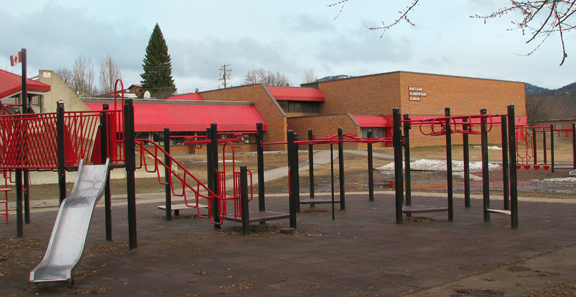Remembering Old Maclean School, Part 2
The aftermath of the February 5, 1981 Maclean school fire was gigantic: 300 students were now without a school, learning materials, and other resources. Teachers and administrative staff were now faced with a host of logistical issues. The school board had a behemoth of a problem on its hands. Everyone felt the loss acutely, especially the students, staff, and Rossland residents who all had histories with the school.
One story that appeared in the Trail Times shortly after the fire featured interviews with some Rossland Old Timers who had attended the school and taught there, and who even remembered the old Central School that Maclean was built to replace. A loss like this triggered a lot of memories. Maclean school had seen many social changes over its decades of existence. Erna Coombs, a long-time Rossland resident whom I remember well from my childhood, taught at the school from 1922 to 1928, and was forced to resign when she got married. That was the policy of the time. At one time, Erna taught a class of 52 students, which was the second largest class the school had, and during the baby boom, the population of the school swelled to the point where five whole classes had to be moved to the Annex in order to accommodate all the students.
Harry Lefevre, who would go on to be mayor of Rossland, was eight years old when Maclean opened its doors in the fall of 1918. Previously, he attended Central School, and he remembered the fire that destroyed that building in 1917.
That fire happened on June 23, which had been the last day of class, and the day everyone had taken their personal belongings home for the summer. Lefevre told the Trail Times, “No one said anything about arson. No one cared. The only one who would have instigated an investigation would have been the school board, but they didn’t.”
62 years later, times had certainly changed. The investigation into the Maclean fire was substantial, and Rossland’s fire chief, who wouldn’t speculate at the time how the fire started, was suspicious enough to decide to call in an expert from Vancouver. This was Fire Marshal Peter Von Heinke, who showed up on February 6 to start looking into the cause of the blaze. On Tuesday, February 10, RCMP Constable Rudy Linke of the General Investigation Section, declared that the fire was being treated as an arson.
Meanwhile the school district jumped into action. A huge clean-up operation began Friday morning, and a bilge pump was brought in to pump water from the ruins of the building into Rossland’s storm drains. Personal belongings and salvageable school items were removed to the Annex and sorted by teachers. Arrangements for housing the displaced students started to take shape. Spearheaded by Superintendent Gib Lind and Secretary-treasurer Bell, locations for temporary classrooms were discussed at a meeting held on the afternoon of February 5. Cook Avenue School didn’t have any available space to accommodate extra students, but RSS did, and in addition to Maclean’s annex and the Catholic parish hall, enough room was found.
By Tuesday February 10, less than a week after the fire, Maclean students were back in class. Kindergarteners went to the Catholic parish hall. Grades 4 through 7, comprised of 163 students, moved to six rooms at RSS. The annex housed four classes, all of them splits. There were two Grade 1 and 2 splits in the basement, and upstairs there was a grade two/three split and a three/four split. I remember the teachers’ names, except one. I was in Sylvia McGregor’s grade 1 class; we had the space in the west half of the basement where the kitchen was – and we were closest to the principal’s office, too. There was a makeshift wall that separated our class from the one occupying the other half of the basement, and I can’t remember that teacher’s name. The two/three split upstairs on the east half of the building was taught by Mrs. D’Aoust, and that was the class I graduated to the next year. The second class upstairs belonged to Mrs. Andersoff.
I mentioned in part one of this piece that there were some remarkable similarities between the Maclean fire and the Central School blaze. It might be that these similarities are only remarkable to me, though. The first one is the unsolved mystery around the suspected arsonists. In the case of Maclean, police did have a suspect, but in the end no charges were laid because there wasn’t sufficient evidence. In the case of Central, though, I haven’t seen any newspaper clippings or other documentation about the fire, from what I gather from what I have read is that it was a no-brainer that it was arson.
There was a lot of circumstantial evidence, and one can only assume, because it’s a small town, there were a lot of rumours, as there were with the Maclean fire. The motive for burning Central might have been political; the building desperately needed either drastic upgrading or, more ideally, complete replacement at a different location, and there was a lot of tension in town about which was the better choice. With Maclean and the evidence of vandalism discovered when the fire was out, it would seem to me (and what do I know?), that some kid felt the urge to indulge in some criminal behaviour that got way out of hand.
Secondly, I think it’s very interesting that after the Central School fire, students were also housed in a parish hall and in a space with a kind of military aspect to it. Back in 1917, students were also housed at the armory; Maclean’s annex used to be a drill hall back in the day. That certainly seems like another case of history repeating itself.
Thirdly, there was the controversy about replacement schools. This was a hotly debated topic both before and after the Central fire, and the replacement of Maclean was no less fervently discussed. With Central, the issue was more location rather than design, though the one faction who wanted to keep the school at its original St. Paul and Fourth Avenue site wanted a redesigned building rather than a relocated one. With Maclean, location wasn’t an issue, but design was. Initially, after the fire, it looked possible that the shell, made of sturdy brick, could be salvaged and the school could be rebuilt using these remains. However, in the end, it was decided that starting anew would be best, and in the summer of 1981, Ed Mayer Contracting demolished the school and the owner and his two sons, according to the Trail Times, sold off a bunch of the bricks.
By the time of the demolition, in July 1981, an architectural design for a new school was already completed and awaiting tender with the Ministry of Education. On July 14, the Trail Times reported that the proposed school was “of a semi-subterranean nature.” In August, the school board received a preliminary cost estimate for the building from the architect that came in at $2.5 million. This fell within the board’s budget of $2 – 3 million. The cost of the new school would be split 50-50 between the Trail district and the province.
But the design wasn’t going over well. I do remember pictures or even a model of the proposed school being available for the public to see, and I recall that a lot of people were not excited about the “semi-subterranean nature” of the building. Perhaps it was too modern-looking, and perhaps the idea of having play space on top of a building rather than around it was too revolutionary. All I know is that the word “ugly” was used in my presence several times when the plans were discussed amongst adults.
School board members were not 100% behind the project, either. Trustee Robert Cacchioni didn’t like the fact that several of the classrooms were designed with windows close to the ceiling. He thought the building was too “stylish” and even said at one meeting, “I think you’re making a serious mistake.” He also questioned why the architect wasn’t asked to create more than one design for consideration other than the semi-subterranean one. Another board member, Jack Bryan, spent months trying to convince his colleagues that the design was unsuitable, and both he and Cacchioni felt that too many of the details had been left up to the architect’s discretion.
In the end, approval was received, and Maclean School V2.0 was open for business in the fall of 1983. I had moved on to Cook Avenue School by then, but I had spent one and a half years in Maclean’s annex. Interestingly enough, the kindergarten class in the old Maclean building was located in the basement, and in February 1981 I found myself yet again in another basement class, though this one in the annex was decidedly more…er, subterranean. It was dark and cavernous and only had windows on the south side, and those were small and had bars on them. The basement of the annex had previously been used as a lunch room for grades one and two, and I remember being lined up every day at lunch time to be marched over there to eat. After the fire, we alternated where we had lunch between our classroom on the west side, where we ate on benches in a corner, and having lunch in the classroom on the other side of the wall, where we sat at desks. We still had use of the playground across the street in the schoolyard, where there was a large play structure. When I moved upstairs for grade two, it was like emerging from a cave: out of the cold and dark and into the light. There were windows, there was sunshine, there seemed to be more space.
I don’t have any memories of returning to class right after the fire, but I do remember one sombre occasion when Mrs. McGregor assembled us in a circle and she asked us each if we were missing anything from the old class. She was compiling a list of items to look out for when she returned to the ruins to look around for missing things. And I remember overhearing her talking to another teacher about both of them taking a baseball bat with them whenever they went over to the ruins because it was creepy for them. The items Mrs. McGregor did bring back from our old school all had a smell I’ll never forget; it was one of those visceral things that stays with you always – the smell intense smoke and charred wood. Sometimes, I smell something similar to that at bonfires, and it takes me back to the smell of smoke-saturated Maclean School detritus.
Phoenixes always rise from ashes. When I look at the current Maclean School, I have to say that the real Phoenix in this story is the old Maclean School. That was one classy old building – and it was on its way to becoming a heritage building, too. As the journalist who wrote the article featuring Erna Coombs and Harry Lefevre indicated in that story, popular opinion at the time was that the new school should be rebuilt using the remaining shell of the old school. I can’t help but agree with that. I still walk by that place and lament the loss of that beautiful, pink-ish brick structure. The site still looks decidedly empty to me.
Mind you, it doesn’t look as empty as the Cook Avenue grounds do now, so I suppose I shouldn’t complain. At least there is still some life at Maclean School. For now. With changes in Rossland’s school configuration so much on everyone’s minds these days, though, I can’t help but wonder if Maclean will once again just be a shell.


























